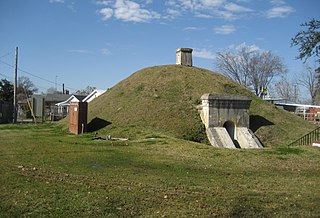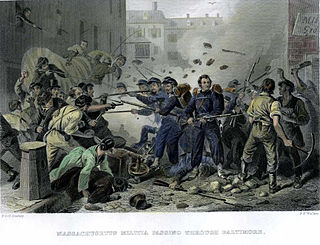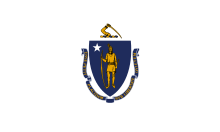
Camp Parapet was a Civil War fortification at Shrewsbury, Jefferson Parish, Louisiana, a bit more than a mile upriver from the current city limits of New Orleans.
The 41st Regiment Massachusetts Volunteer Infantry was a three-year infantry regiment that served in the Union Army during the American Civil War. It was recruited as part of Governors Banks' and Andrew's recruitment drives to supply the union with a military force to hold and expand Union control of the lower Mississippi. In the late winter/early spring of 1863, it was converted to mounted infantry and later to cavalry. On its conversion in June 1863 at Port Hudson, it was disestablished and re-established as the 3rd Massachusetts Volunteer Cavalry.

The 29th Regiment Massachusetts Volunteer Infantry was an infantry regiment in the Union army of the United States during the American Civil War. The regiment was organized in December 1861 when three new companies were attached to a battalion of seven Massachusetts companies that had been in active service since May 1861. These seven companies had been recruited to fill out the 3rd Massachusetts and 4th Massachusetts regiments and had signed on for three years of service. When the 3rd and 4th Massachusetts were mustered out in July 1861, the seven companies that had signed on for three years were grouped together to form a battalion known as the Massachusetts Battalion. Finally, in December 1861, three more companies were added to their roster to form a full regiment and the unit was designated the 29th Massachusetts.

Ansel Dyer Wass was a Union Army officer during the American Civil War. Wass was born in Addison, Maine on November 12, 1832.
The Chalmette Regiment was a regiment of the Louisiana Militia consisting of foreign volunteers called into Confederate service in the American Civil War for 90 days March 1, 1862. Mustered out in May 1862, the regiment was again called into service in May 1863 to defend Fort Beauregard.
The 3rd Massachusetts Volunteer Cavalry Regiment was a cavalry regiment that served in the Union Army during the American Civil War. It was organized by consolidating the 41st Massachusetts Mounted Infantry and the 2nd Battalion Massachusetts Cavalry on June 17, 1863. The regiment served with the XIX Corps, Army of the Gulf during the Red River Campaign in 1864. Its heaviest combat during this campaign took place during the Battle of Sabine Crossroads.

The 3rd Massachusetts Volunteer Militia Regiment was a peacetime regiment of infantry that was activated for federal service in the Union Army for two separate tours during the American Civil War. The regiment consisted of companies from Plymouth and Bristol Counties.

The 5th Regiment Massachusetts Volunteer Militia was a peacetime infantry regiment that was activated for federal service in the Union army for three separate tours during the American Civil War. In the years immediately preceding the war and during its first term of service, the regiment consisted primarily of companies from Essex County as well as Boston and Charlestown.

The 6th Regiment Massachusetts Volunteer Militia was a peacetime infantry regiment that was activated for federal service in the Union army for three separate terms during the American Civil War (1861-1865). The regiment gained notoriety as the first unit in the Union Army to suffer fatal casualties in action during the Civil War in the Baltimore Riot and the first militia unit to arrive in Washington D.C., in response to President Abraham Lincoln's initial call for 75,000 troops. Private Luther C. Ladd of the 6th Massachusetts is often referred to as the first Union soldier killed in action during the war.

The 42nd Regiment Massachusetts Volunteer Infantry was a regiment of infantry that served two tours in the Union Army during the American Civil War. The unit was first formed in September 1862 in response to President Abraham Lincoln's call for 300,000 men to serve for nine months.

The 4th Regiment Massachusetts Volunteer Militia, sometimes known as the 4th Massachusetts Infantry, was a peacetime regiment of infantry that was activated for federal service in the Union Army for two separate tours during the American Civil War. Most of the companies were from Norfolk County, Massachusetts. The regiment had its headquarters in Quincy, Massachusetts.

The 48th Regiment Massachusetts Volunteer Infantry was a regiment of infantry that served in the Union Army during the American Civil War. It was one of the 18 Massachusetts regiments formed in response to President Abraham Lincoln's August 1862 call for 300,000 men to serve for nine months. It consisted of a combination of Essex County companies and Irish-American companies which caused some delay and friction during the unit's formation. The regiment was assigned to the Department of the Gulf and saw heavy combat during the Siege of Port Hudson.

The 49th Regiment Massachusetts Volunteer Infantry was a regiment of infantry that served in the Union Army during the American Civil War. It was one of the 18 Massachusetts regiments formed in response to President Abraham Lincoln's August 1862 call for 300,000 men to serve for nine months. The regiment was recruited in Berkshire County and rendezvoused for mustering in at Camp Briggs in Pittsfield, Massachusetts. William F. Bartlett, a veteran of the 20th Massachusetts was voted colonel in command of the regiment. The 49th Massachusetts was assigned to the Department of the Gulf and saw heavy combat during the Siege of Port Hudson.

The 50th Regiment Massachusetts Volunteer Infantry was a regiment of infantry that served in the Union Army during the American Civil War. It was one of the 18 Massachusetts regiments formed in response to President Abraham Lincoln's August 1862 call for 300,000 men to serve for nine months. The regiment was recruited in Essex County and rendezvoused for mustering in at Camp Edwin M. Stanton in Boxford, Massachusetts. The 50th Massachusetts was assigned to the Department of the Gulf under Major General Nathaniel P. Banks and shipped for Louisiana. The regiment saw combat during the Siege of Port Hudson.

The 52nd Regiment Massachusetts Volunteer Infantry was a regiment of infantry that served in the Union Army during the American Civil War. It was one of the 18 Massachusetts regiments formed in response to President Abraham Lincoln's August 1862 call for 300,000 men to serve for nine months. The regiment was recruited in Franklin and Hampshire Counties and rendezvoused for mustering in at Camp Miller in Greenfield, Massachusetts. The 52nd Massachusetts was assigned to the Department of the Gulf under Major General Nathaniel P. Banks and shipped for Louisiana. The regiment participated in the Bayou Teche campaign in western Louisiana during April and May 1863 and then saw combat during the Siege of Port Hudson.

The 57th Regiment Massachusetts Volunteer Infantry was a regiment of infantry that served in the Union Army during the American Civil War. It was one of the four "Veteran Regiments" raised in Massachusetts during the winter of 1863–64. Recruits of these regiments were required to have served at least nine months in a prior unit. Colonel William F. Bartlett, at age 24 already a veteran of three regiments, organized the recruiting and formation of the 57th Massachusetts and served as its first commanding officer.

The 6th Massachusetts Battery was an artillery battery that served in the Union Army during the American Civil War. The unit was one of the Massachusetts regiments organized in response to President Abraham Lincoln's call on May 2, 1861 for volunteer troops to serve a term of three-years. The battery trained at Camp Chase in Lowell, Massachusetts. It was assigned to the Department of the Gulf under Major General Benjamin F. Butler and departed Boston by steamship on February 8, 1862. At that time, the unit comprised 145 men armed with two rifled and four smoothbore six-pounder field guns.

The 7th Massachusetts Battery was an artillery battery that served in the Union Army during the American Civil War. The original core of the unit was a company of infantry known as the Richardson Light Guard. The company initially served provost duty at Fortress Monroe, was eventually trained in light artillery drill, and reorganized on March 17, 1862 as the 7th Massachusetts Battery.

The 13th Massachusetts Battery was an artillery battery that served in the Union Army during the American Civil War. The unit was organized at Camp Meigs near Boston during the fall of 1862. Its members were mustered in at various times over the fall and the officers mustered into federal service on November 3, 1862. It was assigned to the Department of the Gulf commanded by Major General Nathaniel P. Banks and departed Massachusetts by steamship on January 20, 1863.

The 4th United States Colored Cavalry Regiment was an African American cavalry regiment that served in the Union Army during the American Civil War. The regiment mustered in as the 1st Cavalry (Corps d'Afrique) at New Orleans on September 12, 1863 and was stationed for the entirety of its existence at various bases throughout Louisiana, mustering out at New Orleans on March 20, 1866.









